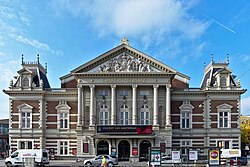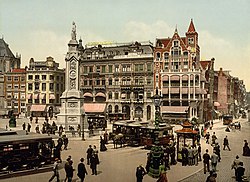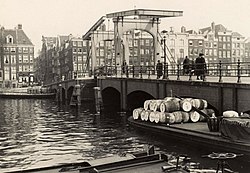Amsterdam
Amsterdam is the capital and largest city in the European country of the Netherlands. Amsterdam is famous for its canals. Unlike in capitals of most other countries, the national government, parliament, government ministries, supreme court, royal family and embassies are not in Amsterdam, but in The Hague. The only diplomatic offices present in Amsterdam are consulates.
City and municipality | |
|
Images, from top down, left to right: Grachtengordel, one of Amsterdam's canals, Royal Concertgebouw, Rijksmuseum | |
|
| |
|
| |
| Coordinates: 52°22′N 4°53′E / 52.367°N 4.883°E | |
| Country | |
| Province | |
| Boroughs | Eight districts
|
| Government | |
| • Body | Municipal council |
| • Mayor | Femke Halsema (GreenLeft) |
| Area | |
| • Municipality | 243.65 km2 (94.07 sq mi) |
| • Land | 188.29 km2 (72.70 sq mi) |
| • Water | 55.36 km2 (21.37 sq mi) |
| • Randstad | 3,043 km2 (1,175 sq mi) |
| Elevation | −2 m (−6.6 ft) |
| Population | |
| • Municipality | 904,704 |
| • Density | 4,805/km2 (12,440/sq mi) |
| • Urban | 1,351,587 |
| • Metro region | 2,431,000 |
| • Randstad | 7,100,000 |
| Time zone | UTC+1 (CET) |
| • Summer (DST) | UTC+2 (CEST) |
| Postcode | 1011–1109, 1381–1384 |
| GeoTLD | .amsterdam |
| Website | Official website |
The city hosts two universities (the University of Amsterdam and the Free University Amsterdam) and an international airport "Schiphol Airport". About 2.2 million people live in the metropolitan area. The city of Amsterdam is the world's most multi-cultural city. It has people living there from 175 different countries. Like other big cities in the Netherlands and elsewhere in the world, Amsterdam is unfortunately subjected to many criminal activities.
The former city of Weesp has been part of Amsterdam since 24 March 2022. Because of this Amsterdam has about 905,000 people.
History
A dam was built in 13th century in the river Amstel (that's why the city is called Amsterdam). The old harbor of the city, Damrak, is now one of the busiest streets in the city. The city was for the first time mentioned in 1275 by count Floris V, count of Holland and Zeeland who gave the people of Amsterdam some more freedom. The city got its city rights probably in 1306; at least soon after the year 1300. The city became a major trading port pretty soon, with a successful trading route to the Baltic Sea. The city grew fast in the 15th century. Because the city basically lies in swamp, the builders of the city had to dig canals to use the digging-ground for getting the living-ground higher. Homes were built on wooden poles, and the canals served as a pretty effective primitive sewer. Amsterdam sits at two meters below sea level and is built on soft peat and clay, in order to stay above water.[9][10]
The city was one of the first cities in Western Europe to be fairly democratic: Wealthy citizens chose the leaders of the city. Amsterdam declared war on the Spanish in 1578, during the Eighty Years' War. When the city of Antwerp fell to the Spanish in 1585, many people of Antwerp fled to Amsterdam. Antwerp was also a major trading city, and when its people moved to Amsterdam, they took their trading-networks with them. That's why Amsterdam became an even more important trading city after that. This launched the Dutch Golden Age. The number of people living in Amsterdam during the War rose from less than 30,000 in 1570 to over 100,000 in 1622. That number would even rise to 200,000 near the end of the 17th century, making the city a very large city for its time (only London and Paris also had that many people). In the 18th century, the number of people living in Amsterdam fell back to 140,000, ending the Golden Age.
The 19th century was the time for the first trains and trams in Amsterdam. The first train ran from Amsterdam to Haarlem in 1839. The number of people was rising, with about 250,000 living in Amsterdam in 1850, and more than 500,000 in 1900. Amsterdam was a heavy industrialised city by then. Before the Second World War, there were about 140,000 Jews living in Amsterdam. Most of those people did not survive the war. After the war, Amsterdam became a centre of tolerance and culture; to be different is not abnormal in Amsterdam. It is expected that Amsterdam will grow 12.6% until 2025. It will then hold almost 900,000 people, and the metropolitan area will hold almost 2.5 million people by then.[11]
Districts
Amsterdam consists of eight districts:
- Centrum
- Noord
- West
- Nieuw-West
- Zuid
- Oost
- Zuidoost
- Westpoort
And one urban area:
- Weesp
Amsterdam Media
The Oude Kerk was consecrated in 1306 AD.
Amsterdam citizens celebrating the Peace of Münster, 30 January 1648. Painting by Bartholomeus van der Helst
Courtyard of the Amsterdam Stock Exchange by Emanuel de Witte, 1653. The Amsterdam Stock Exchange was the first stock exchange to introduce continuous trade in the early 17th century.
View of Vijzelstraat looking towards the Muntplein, 1891
Photochrom of Amsterdam's Dam Square at the beginning of the 20th century
The rebuilt Magere Brug around 1938
People celebrating the liberation of the Netherlands at the end of World War II on 8 May 1945
The 17th-century Canals of Amsterdam were listed as UNESCO World Heritage Sites in 2010, contributing to Amsterdam's fame as the "Venice of the North".[unreliable source?][unreliable source?] Along with De Wallen, the canals are the focal point for tourists in the city.
References
- ↑ "Portfolios: Mayor & Alderpersons". Gemeente Amsterdam. Archived from the original on 28 February 2014. Retrieved 18 February 2014.
- ↑ "Kerncijfers wijken en buurten 2020" [Key figures for neighbourhoods 2020]. StatLine (in Nederlands). CBS. 24 July 2020. Retrieved 19 September 2020.
- ↑ 3.0 3.1 Anita Bouman–Eijs; Thijmen van Bree; Wouter Jonkhoff; Olaf Koops; Walter Manshanden; Elmer Rietveld (17 December 2012). De Top 20 van Europese grootstedelijke regio's 1995–2011; Randstad Holland in internationaal perspectief [Top 20 of European metropolitan regions 1995–2011; Randstad Holland compared internationally] (PDF) (Technical report) (in Dutch). Delft: TNO. Archived from the original (PDF) on 3 March 2014. Retrieved 25 July 2013.
{{cite techreport}}: CS1 maint: unrecognized language (link) - ↑ "Postcodetool for 1012JS (Dam Square)". Actueel Hoogtebestand Nederland (in Dutch). Het Waterschapshuis. Archived from the original on 21 September 2013. Retrieved 18 February 2014.
{{cite web}}: CS1 maint: unrecognized language (link) - ↑ "Bevolkingsontwikkeling; regio per maand" [Population growth; regions per month]. CBS Statline (in Dutch). CBS. 27 October 2017. Retrieved 27 October 2017.
{{cite web}}: CS1 maint: unrecognized language (link) - ↑ "Bevolkingsontwikkeling; regio per maand" [Population growth; regions per month]. CBS Statline (in Dutch). CBS. 26 June 2014. Retrieved 24 July 2014.
{{cite web}}: CS1 maint: unrecognized language (link) - ↑ "CBS Amsterdam Bevolkingsontwikkeling; regio per maand".
- ↑ "Economische Verkenningen Metropool Regio Amsterdam". Archived from the original (PDF) on 2018-12-25. Retrieved 2018-04-05.
- ↑ "Keeping Holland Above Water: The Facts Behind the Epic Struggle". The Atlantic. Retrieved 20 July 2024.
- ↑ "13 fun facts you might not know about Amsterdam". GetYourGuide. Retrieved 20 July 2024.
- ↑ Randstad groeit, platteland krimpt (in Dutch)
Other websites
| Wikimedia Commons has media related to Lua error in Module:Commons_link at line 62: attempt to index field 'wikibase' (a nil value).. |
















